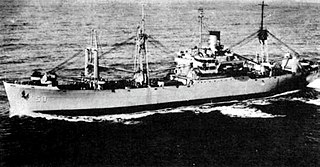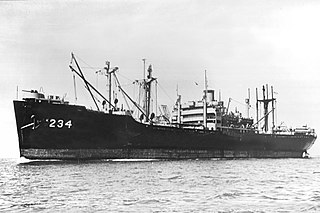
USS Mazama (AE‑9) was a US Navy ammunition ship laid down 14 April 1942 by the Tampa Shipbuilding Co., Tampa, Fla.; launched 15 August 1943; sponsored by Mrs. Edward V. Rickenbacker; and commissioned 10 March 1944. She was named for Mount Mazama, a collapsed volcano in the Cascade Range in Oregon whose caldera is now occupied by Crater Lake.

USS Mauna Loa (AE-8) an ammunition ship in service with the United States Navy. She was commissioned from 1944 to 1947, and recommissioned between 1955 and 1958 and from 1960 to 1969. Mauna Loa was finally scrapped in 1984.

USS Rainier (AE-5), the second US Navy vessel named after Mount Rainier, was laid down on 14 May 1940 by the Tampa Shipbuilding Co., Tampa, Fla., as Rainbow ; launched 1 March 1941; sponsored by Mrs. Robert E. Anderson; transferred to the US Navy on 16 April 1941; converted for use as an ammunition auxiliary; and commissioned as Rainier (AE-5) on 21 December 1941 at Norfolk, Va..

USS Wrangell (AE-12) was laid down under a Maritime Commission contract as SS Midnight during February 1944 at Wilmington, North Carolina, by the North Carolina Shipbuilding Company; launched on 14 April 1944; sponsored by Mrs. G. T. Cambell; delivered to the Navy, incomplete, on 28 May 1944; moved to Hampton Roads; converted to an ammunition ship by the Norfolk Shipbuilding and Drydock Co.; and commissioned on 10 October 1944 at the Norfolk Navy Yard.

The fourth USS Vesuvius (AE-15) was laid down under a Maritime Commission contract by the North Carolina Shipbuilding Company, Wilmington, N.C.; launched on 26 May 1944; acquired by the United States Navy on 4 July 1944; and commissioned on 16 January 1945.

USS Shasta (AE-33) was a Kilauea-class replenishment ammunition ship of the United States Navy. She was named after Mount Shasta, a volcano in the Cascade Range in northern California. Shasta's mission was to support forward deployed aircraft carrier battle groups, which she accomplished through underway replenishment and vertical replenishment. Over three decades, Shasta and her crew took part in the Vietnam War, the Cold War, the Iran–Iraq War, Desert Shield/Operation Desert Storm, and numerous other actions.

USS Nantahala (AO–60), the second ship of this name, was laid down under Maritime Commission contract by Bethlehem Sparrows Point Shipyard, Inc., Sparrows Point, Maryland, on 31 October 1943. Launched on 29 April 1944; sponsored by Miss Mary Louise Reed; delivered to the Navy 19 June 1944; and commissioned the same day.

USS Weeden (DE-797) was a Buckley-class destroyer escort in service with the United States Navy from 1944 to 1946 and from 1950 to 1958. She was scrapped in 1969.

USS Tulare (AKA-112/LKA-112) was a Tulare-class attack cargo ship in service with the United States Navy from 1956 to 1986. She was sold for scrap in 2011.

USS Alshain (AKA-55) was an Andromeda-class attack cargo ship in the service of the United States Navy. She was named after the star Alshain in the constellation Aquila, and served as a commissioned ship for 11 years and 9 months.

USS Chara (AKA-58) was an Andromeda-class attack cargo ship named after a star in the constellation Canes Venatici. She was later converted to an ammunition ship and redesignated (AE-31).

USS Diphda (AKA-59) was an Andromeda-class attack cargo ship named after a star in the constellation Cetus. She served as a commissioned ship for 11 years and 10 months.

USS Virgo (AKA-20) was an Andromeda class attack cargo ship of the United States Navy, named after the constellation Virgo. She was later converted to an ammunition ship and redesignated as (AE-30). She served as a commissioned ship for 22 years and 4 months.

USS Saranac (AO-74), originally named the SS Cowpens, was a Type T2-SE-A1 Suamico-class fleet oiler of the United States Navy, and the fourth ship of the Navy to bear the name.

USS Botetourt (APA-136) was a Haskell-class attack transport in service with the United States Navy from 1945 to 1946 and from 1950 to 1956. She was scrapped in 1974.

USS Marias (AO-57) was a Cimarron-class fleet oiler acquired by the U.S. Navy during World War II. She served her country primarily in the Pacific Ocean Theatre of Operations, and provided petroleum products where needed to combat ships. For performing this dangerous task, she was awarded eight battle stars during World War II, and one campaign star during the Vietnam War for her bravery in combat areas.

USS Yosemite (AD-19) was a Dixie-class destroyer tender built during World War II for the U.S. Navy. Her task was to service destroyers in, or near, battle areas and to keep them fit for duty.

USS Telfair (APA/LPA-210) was a Haskell-class attack transport that saw service with the US Navy in World War II and the Korean War. She remained in service through most of the 1950s and 1960s, where she participated in various peacetime operations. Telfair was named for Telfair County, Georgia, which was itself named after Edward Telfair, the second Governor of the state, a member of the Continental Congress, and a signer of the Articles of Confederation.

USS Belle Grove (LSD-2) was an Ashland-class dock landing ship of the United States Navy, named in honor of Belle Grove Plantation, the birthplace of President James Madison (1751–1836) in Port Conway, Virginia.

USS Bucyrus Victory (AK-234) was a Boulder Victory-class cargo ship acquired by the U.S. Navy during World War II. She served in the Pacific Ocean theatre of operations through the end of the war, earning one battle star, and then returned to the United States for disposal.




















